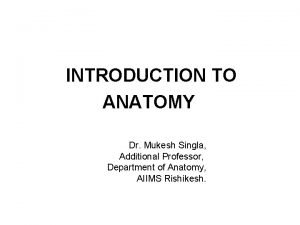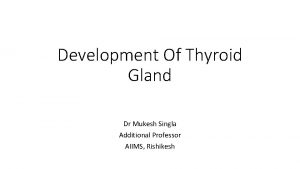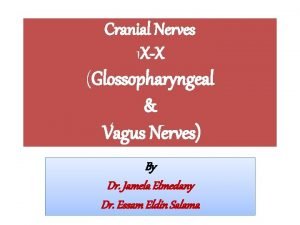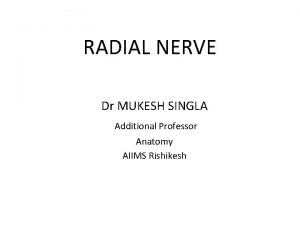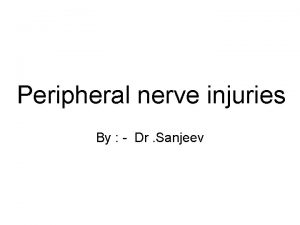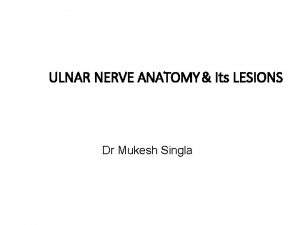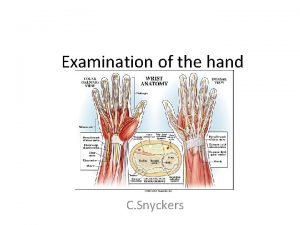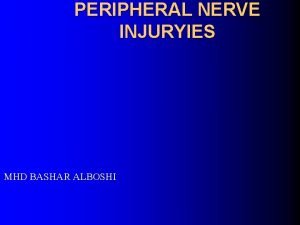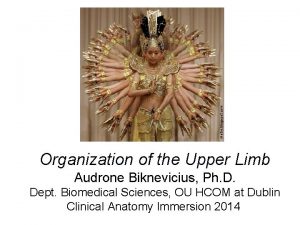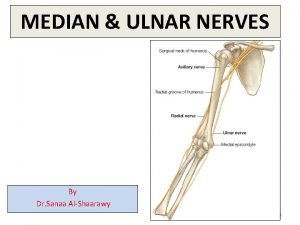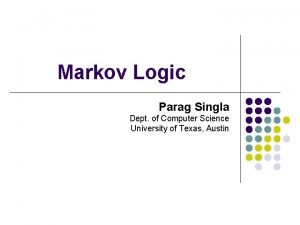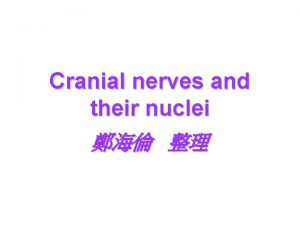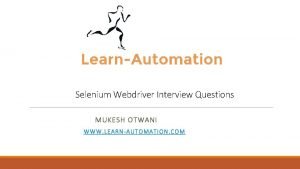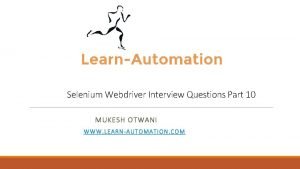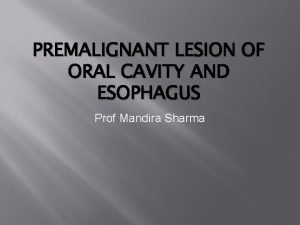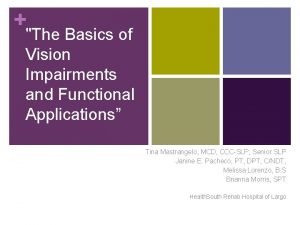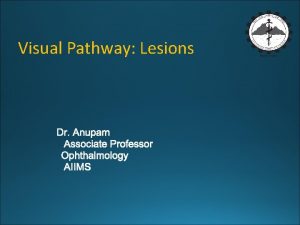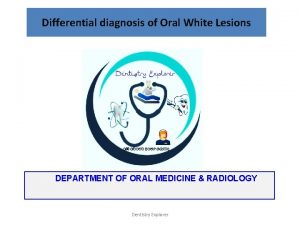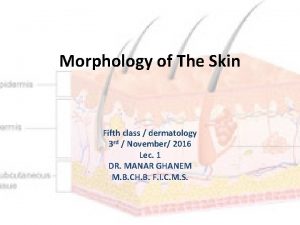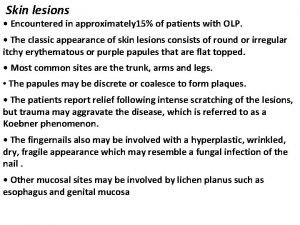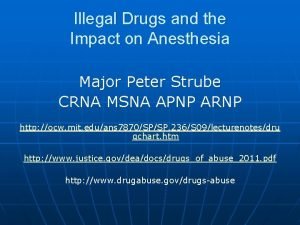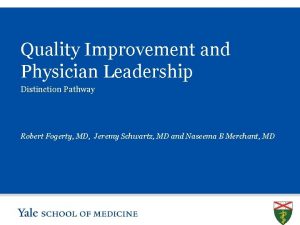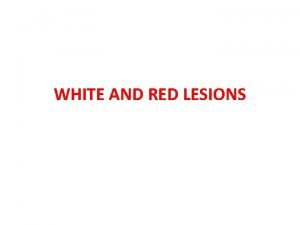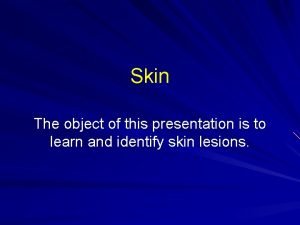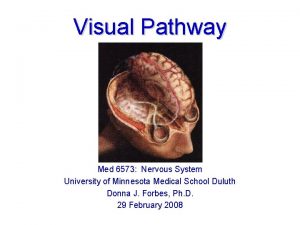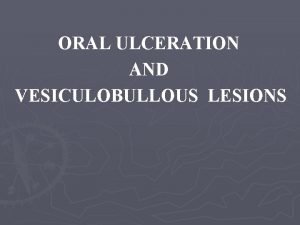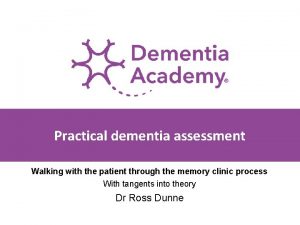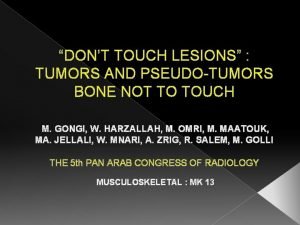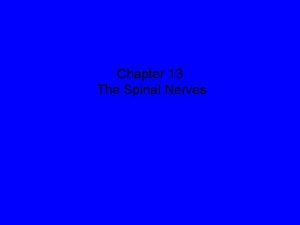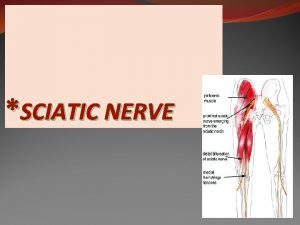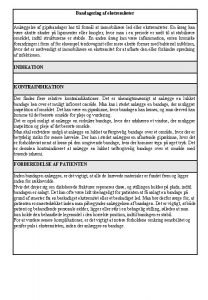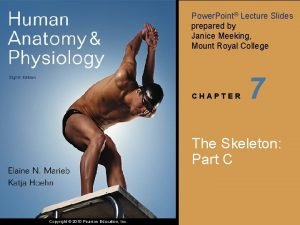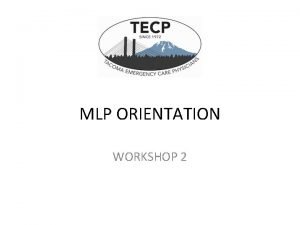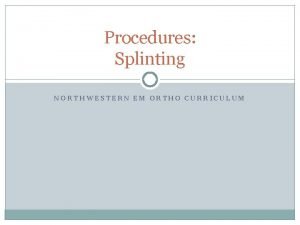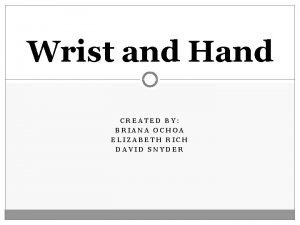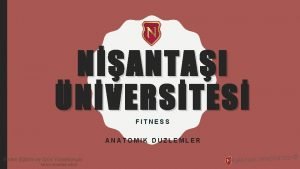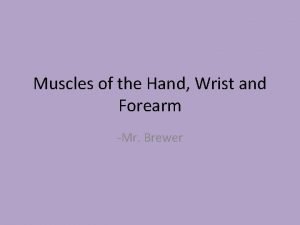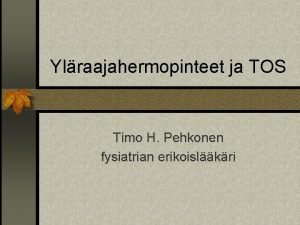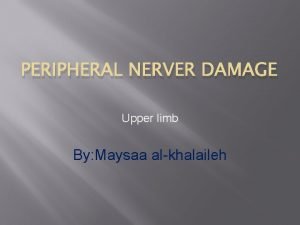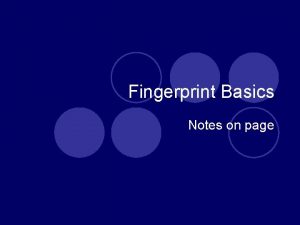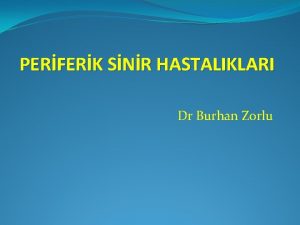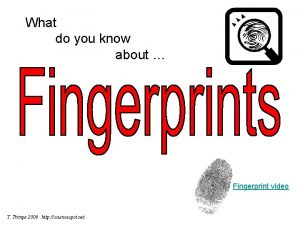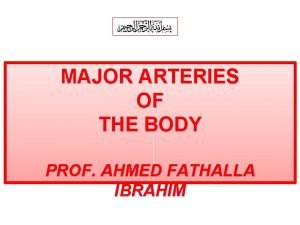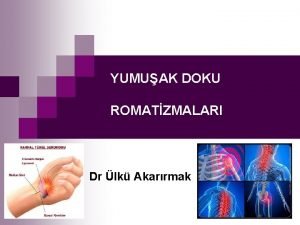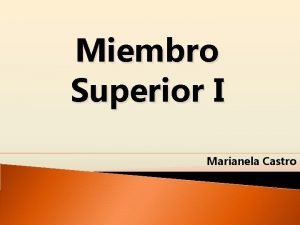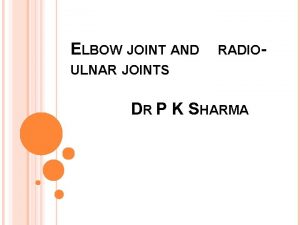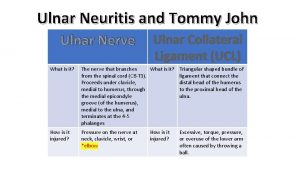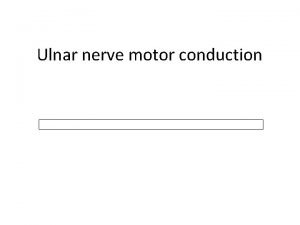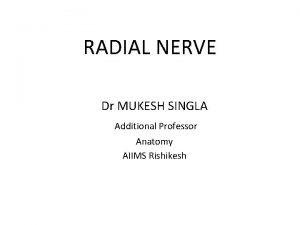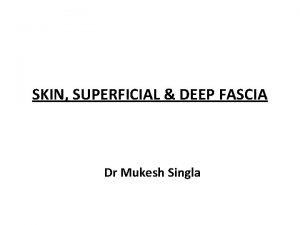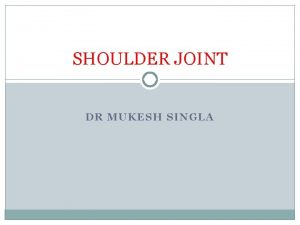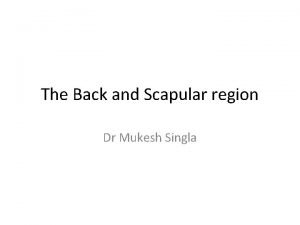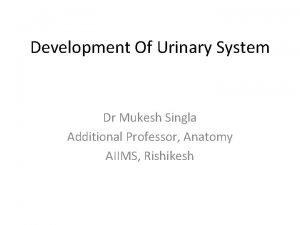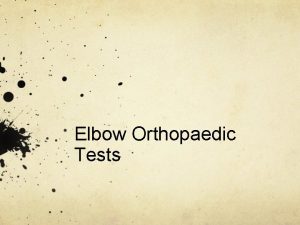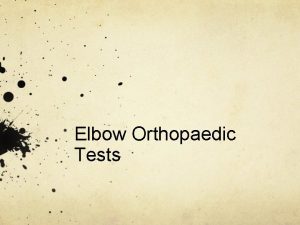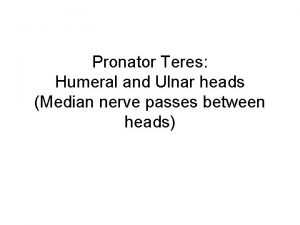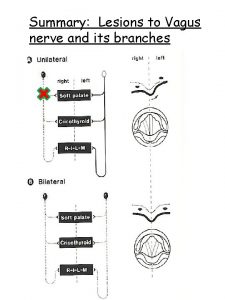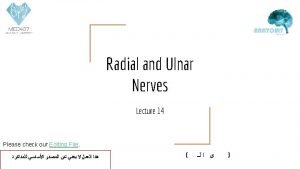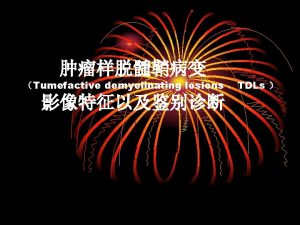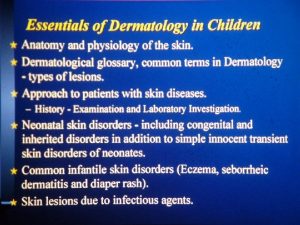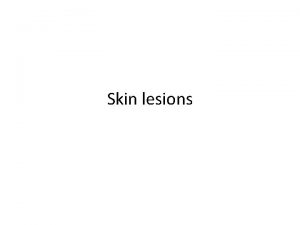ULNAR NERVE ANATOMY Its LESIONS Dr Mukesh Singla


























































- Slides: 58

ULNAR NERVE ANATOMY & Its LESIONS Dr Mukesh Singla

Learning Objectives 1. Ulnar nerve formation , root value and important relations 2. Motor and sensory supply 3. Important sites of injuries/entrapment of nerve 4. Effects of injury of ulnar nerve 5. How to clinically test ulnar nerve injury

Ulnar nerve C 8 T 1 Origin : medial cord of brachial plexus , runs medial to brachial artery - middle of arm. At coracobrachialis insertion, - pierces medial intermuscular septum, is accompanied by superior ulnar collateral artery – and enter posterior compartment of arm. At elbow - posterior to medial epicondyle. No branches in arm. 30

Ulnar nerve in forearm • It continues downward to enter in forearm • b/w two heads of flexor carpi ulnaris. Passes through CUBITAL TUNNEL • It runs down forearm between FCUand FDP. • In lower half of forearm it lies medial to ulnar artery. 31

Cubital Tunnel Cubital tunnel is a space of dorsal medial elbow which allows passage of the ulnar nerve around the elbow. It is bordered Medially - medial epicondyle of the humerus, laterally -olecranon process of the ulna and tendinous arch joining the humeral and ulnar heads of the flexor carpi ulnaris.

Cubital Tunnel


Ulnar nerve in Forearm • Flexor carpi ulnaris. • Medial ½ of FDP • Articular: elbow joint. • Dorsal or posterior cutaneous branch: • Dorsal surface - medial 1/3 rd of hand 1½ fingers. • Palmar cutaneous branch : to supply skin of palm of hand medial 1½ fingers. 32

Ulnar nerve in Hand 33

Ulnar nerve in Hand After it travels down the ulna, ulnar nerve enters the palm of the hand. At the wrist, the ulnar nerve and artery lie in a canal formed by the pisiform bone medially and the hook of hamate laterally (Guyon’s canal). In this region the nerve divides into two branches. The Superficial sensory Branch The Deep Motor Branch

Ulnar nerve in Hand The superficial branch is generally considered a sensory branch which supplies to distal palm, fifth and half of the fourth digit. It also supplies palmaris brevis, a thin muscle beneath the skin which cannot be studied electromyographically. The deep branch gives off motor innervation to the hand muscles.

WRIST TO (MEDIAL) HAND

Ulnar nerve in Hand Deep branch: • Runs b/w abductor digiti minimi & flexor digiti minimi. • pierces opponens digiti minimi. • Then passes laterally within concavity of deep palmar arch. • lies deep to flexor tendons. • It supplies 14 muscles : • Three hypothenar muscles. • Adductor pollicis. • All dorsal & palmar interossei. • Medial 2 lumbricals. 35


BRANCHES: Muscular FCU, FDP (medial half), palmaris brevis, hypothenar muscles, medial 2 lumbricals, all palmar & dorsal interossei , thumb intrinsics medial to FPL {adductor pollicis , flexor pollicis brevis (deep head)} Cutaneous palmar cutaneous supply to hypothenar eminence Dorsal cutaneous supply dorsum of hand (medial part), dorsum of little finger , part of dorsum of ring finger. Digital forms the main sensory branches to the ring and little finger Vascular & Articular No branches above elbow

DORSAL CUTANEOUS BRANCH

PALMAR CUTANEOUS BRANCH

Guyon Canal or Tunnel Semi-rigid longitudinal canal in the wrist that allows passage of the ulnar artery and ulnar nerve into the hand. Roof of the canal -superficial palmar carpal ligament, deeper flexor retinaculum and hypothenar muscles comprise the floor. The space is medially bounded by the pisiform and pisohamate ligament more proximally, and laterally bounded by the hook of the hamate more distally. It is approximately 4 cm long, beginning proximally at the transverse carpal ligament and ending at the aponeurotic arch of the hypothenar muscles.



Lesion of ulnar nerve above elbow - atrophy of hypothenar muscles

Lesion of ulnar nerve above elbow • Weakness of flexion at wrist paralysis of FCU • Loss of flexion of terminal phalanges of ring & little fingers paralysis of medial ½ of FDP • Paralysis of all interossei & medial 2 lumbricals (3 rd & 4 th). • Characteristic deformity is - partial claw hand. • Atrophy of hypothenar muscles. • Fingers - hyperextended at metacarpophalangeal joints & flexed at interphalangeal joints - ring & little finger. • Loss of adduction of hand & thumb due to paralysis of flexor carpi ulnaris & adductor pollicis.

Lesion of ulnar nerve above elbow - Loss of cutaneous sensations on front & dorsum of medial 1/3 of hand + medial 1 ½ fingers.

Lesion of ulnar nerve above wrist • It leads to paralysis of intrinsic muscles of hand as described above. • deformity ‘claw hand’ • Lossof cutaneous sensations of medial 1 ½ fingers. Test for Palmar interossei for adduction of fingers. Test for adductor & opponens pollicis.

Test for Palmar interossei for adduction of fingers. Test for adductor & opponens pollicis.


Ulnar Nerve Injuries most commonly injured @ At elbow where it lies behind the medial epicondyle usually associated with fracture At wrist where it lies with the ulnar artery in front of the flexor retinaculum.

Injuries to the Ulnar Nerve at the Elbow CUBITAL TUNNEL SYNDROME (2 ND most common) Motor Flexor carpi ulnaris & medial half of flexor digitorum profundus ring & little fingers No flexion of the terminal phalanges of the ring & little fingers Flexion of wrist = abduction paralysis of flexor carpi ulnaris medial border of the front of the forearm flattned/wasted All the small muscles of the hand paralyzed EXCEPT ?

Injuries to the Ulnar Nerve @ the Elbow Motor Extensor digitorum can abduct the fingers to a small extent when metacarpophalangeal joints are hyperextended Impossible to adduct the thumb adductor pollicis paralyzed Froment’s sign Grip a piece of paper between the thumb and index fingers Froment sign: The patient is asked to hold the paper between the thumb and index finger. (A) With the intact ulnar nerve, the patient is able to make use of the adductor pollicis. ( B) When the ulnar nerve is deficient, the patient compensates for the denervated adductor by using the flexor pollicis longus (median nerve innervated).

Injuries to the Ulnar Nerve @ the Elbow Motor 2 medial lumbricals & interossei Hyperextended metacarpophalangeal joints Flexed interphalangeal joints fourth & fifth fingers “claw” deformity main en griffe

Injuries to the Ulnar Nerve @ the Elbow Motor Flattening of hypothenar eminence Loss of the convex curve to the medial border of the hand Hollowing between metacarpal bones @ dorsum of the hand wasting of dorsal interossei

Injuries to the Ulnar Nerve @ the Elbow Sensory Loss of skin sensation anterior & posterior surfaces of medial 1/3 of the hand medial 1 ½ fingers Vasomotor Changes warmer and drier skin area arteriolar dilatation and absence of sweating /loss of sympathetic control

Injuries to the Ulnar Nerve @ the Wrist Motor Small hand muscles paralyzed, wasted – EXCEPT 3 thenar @ first 2 lumbricals Claw hand More obvious Flexor digitorum profundus intact Marked flexion of the terminal phalanges Ulnar paradox Higher lesion Less obvious claw deformity More proximal injury Less claw

ULNAR NERVE ENTRAPMENT SYNDROMES PROXIMAL/ @ ELBOW CUBITAL TUNNEL SYNDROME BETWEEN MEDIAL EPICONDYLE & FLEXOR CARPI ULNARIS Q: Medial half of Flexor digitorum profundus affected in which one most? DISTAL/ @ WRIST GUYON’S CANAL Roof: Palmaris brevis, hamate, pisiforme bones & FCU

Froment’s sign To perform the test, a patient is asked to hold an object, usually a flat object such as a piece of paper, between their thumb and index finger (pinch grip). The examiner then attempts to pull the object out of the subject's hands. [2] Froment’s sign : hyperflexion of IP jt of thumb while attempting a lateral pinch(indicates paralysis of adductor pollicis, 1 st DI , with replacement of pinch function by FPL)

Ulnar paradoxus In proximal ulnar lesion (closer to the elbow), the Flexor Digitorum Profundus may also be denervated. As a result, flexion of the Interphalangeal joints is weakened, which reduces the claw-like appearance of the hand. In distal lesion, at or below wrist Condition of claw hand is worse because as FDP is spared , there is active flexion of interphalangeal joint of medial two digits. This is called the “ulnar paradox” because one would normally expect a more debilitating injury to result in a more deformed appearance.

Cross your fingers test: Inability to cross the middle finger dorsally over the index finger or vise versa. (1 st PI & 2 nd DI)

Some Facts • At the back of medial epicondyle, ulnar nerve is lodged in a groove. • Pressure on nerve at this site produce “ funny bone , symptoms with tingling along hypothenar eminence and little finger

Some Facts • Deep branch of ulnar nerve is called “musician” nerve because it innervates all the small muscles of hand involved in fine movement • Median nerve- eye of hand because it supply sensory receptors in the tips of medial three and half fingers of hand • Median nerve – laborer’s nerve because of motor supply to long flexor tendons

which of these symptoms is not caused by damage to the median nerve at the wrist? A ape/simian hand B loss of pronation C loss of sensation in most of thumb and digits 2 and 3. D thenar muscle paralysis

which of these symptoms is not caused by damage to the median nerve at the wrist? A ape/simian hand B loss of pronation C loss of sensation in most of thumb and digits 2 and 3. D thenar muscle paralysis

• Injury to the ulnar nerve at the ____ causes ______, and at the ____ causes ____ • A • elbow, radial deviation, wrist drop • B • elbow, radial wrist deviation, wrist, severe clawing of hand • C • elbow, severe clawing of hand, wrist, radial deviation • D • elbow, wrist drop, wrist, radial deviation

• Injury to the ulnar nerve at the ____ causes ______, and at the ____ causes ____ • A • elbow, radial deviation, wrist drop • B • elbow, radial wrist deviation, wrist, severe clawing of hand • C • elbow, severe clawing of hand, wrist, radial deviation • D • elbow, wrist drop, wrist, radial deviation

• A patient after injury on hand presents with hand in claw position with 4 th and 5 th fingers extended at the metacarpophalangeal joints and flexed at the interphalangeal joints. Which nerve is involved in this injury • Radial nerve • Median nerve • Ulnar nerve • Anterior interosseous nerve

• A patient after injury on hand presents with hand in claw position with 4 th and 5 th fingers extended at the metacarpophalangeal joints and flexed at the interphalangeal joints. Which nerve is involved in this injury • Radial nerve • Median nerve • Ulnar nerve • Anterior interosseous nerve

Froment’s sign is used to test the strength of which muscle a) Abductor Pollicis longus b) Adductor Pollicis c) Flexor Pollicis longus d) Extensor Pollicis Longus 2.

Froment’s sign is used to test the strength of which muscle a) Abductor Pollicis longus b) Adductor Pollicis c) Flexor Pollicis longus d) Extensor Pollicis Longus

• A patient is asked by his physician to hold their wrist in complete and forced flexion (pushing the dorsal surfaces of both hands together) for 30– 60 seconds. This maneuver compress the nerve within the carpal tunnel and characteristic symptoms (such as burning, tingling or numb sensation over the thumb, index, middle and ring fingers) conveys a positive test result and suggests carpal tunnel syndrome. What is the name of manoeuvre physician is performing • Turning Circle maneure • Phalen’s Manoeuvre • Collision Avoidance Manoeuvre • Zig-zag Test Manoeuvre.

1. A patient is asked by his physician to hold their wrist in complete and forced flexion (pushing the dorsal surfaces of both hands together) for 30– 60 seconds. This maneuver compress the nerve within the carpal tunnel and characteristic symptoms (such as burning, tingling or numb sensation over the thumb, index, middle and ring fingers) conveys a positive test result and suggests carpal tunnel syndrome. What is the name of manoeuvre physician is performing a) Turning Circle maneure b) Phalen’s Manoeuvre c) Collision Avoidance Manoeuvre d) Zig-zag Test Manoeuvre.

• A clinical condition in which patient shows inability to abduct the thumb due to median nerve lesion is called • a. • b. • c. • d. Pollock ‘s Sign Pointing Index Ape thumb deformity Andre- Thomas Sign

A clinical condition in which patient shows inability to abduct the thumb due to median nerve lesion is called a. Pollock ‘s Sign b. Pointing Index c. Ape thumb deformity d. Andre- Thomas Sign

The index finger is not flexed at the proximal interphalangeal (PIP) and distal interphalangeal (DIP) joints. This clinical condition is called pointing index. This condition is due to lesion of a) Ulnar nerve b) Median nerve c) Radial nerve d) Posterior interosseous nerve

The index finger is not flexed at the proximal interphalangeal (PIP) and distal interphalangeal (DIP) joints. This clinical condition is called pointing index. This condition is due to lesion of a) b) c) d) Ulnar nerve Median nerve Radial nerve Posterior interosseous nerve

Pen test in hand is performed to assess the neuromuscular status of: a) Opponens pollicis b) Flexor pollicis brevis c) Abductor pollicis brevis d) First palmar interossei

Pen test in hand is performed to assess the neuromuscular status of: a) Opponens pollicis b) Flexor pollicis brevis c) Abductor pollicis brevis d) First palmar interossei

In the phalen’s test, the suspected compression of median nerve is elicited. Which of the following are the other structures passing through the carpal tunnel? • a. Ulnar nerve • b. Superficial cutaneous branch • c. Flexor digitorum profundud tendons • d. Palmaris longus tendon

In the phalen’s test, the suspected compression of median nerve is elicited. Which of the following are the other structures passing through the carpal tunnel? a. Ulnar nerve b. Superficial cutaneous branch c. Flexor digitorum profundud tendons d. Palmaris longus tendon

 Subdivision of anatomy
Subdivision of anatomy Mukesh singla
Mukesh singla Lesions of vagus nerve
Lesions of vagus nerve Radial nerve anatomy elbow
Radial nerve anatomy elbow Aeroplane splint for brachial plexus
Aeroplane splint for brachial plexus Masse sign
Masse sign Claw hand
Claw hand Groove for ulnar nerve
Groove for ulnar nerve N radialis
N radialis Nerves in hand
Nerves in hand Parag singla
Parag singla Adish singla
Adish singla Parag singla
Parag singla Trigeminal nerve which cranial nerve
Trigeminal nerve which cranial nerve Mukesh png text
Mukesh png text Mukesh otwani selenium interview questions
Mukesh otwani selenium interview questions Mukesh otwani
Mukesh otwani Think big think fast
Think big think fast Esophagus
Esophagus Convergence insufficiency athens
Convergence insufficiency athens G j mount classification of caries
G j mount classification of caries Pie in the sky lesion
Pie in the sky lesion White lesions
White lesions Oral pathology
Oral pathology Daughter mother grandmother pancreatic lesions
Daughter mother grandmother pancreatic lesions Primary and secondary lesions of skin
Primary and secondary lesions of skin Site:slidetodoc.com
Site:slidetodoc.com Nature lésions
Nature lésions Extrapyramidal tract names
Extrapyramidal tract names Periradicular diseases
Periradicular diseases Olneys lesions
Olneys lesions Lésions
Lésions Necrosis
Necrosis White lesions
White lesions Describing skin lesions
Describing skin lesions Monocular visual field
Monocular visual field Extrapyramidal tract names
Extrapyramidal tract names Vesiculobullous lesions
Vesiculobullous lesions Scattered white matter lesions
Scattered white matter lesions Don't touch lesion
Don't touch lesion Spinal cord nerve anatomy
Spinal cord nerve anatomy Sciatic nerve sensation
Sciatic nerve sensation Cirkulær gips
Cirkulær gips Acromion
Acromion Double sugar tong splint
Double sugar tong splint Posterior ankle splint with stirrup
Posterior ankle splint with stirrup Extensor carpi radialis longus
Extensor carpi radialis longus Transvers
Transvers Wrist muscles
Wrist muscles Pronator teres antagonist
Pronator teres antagonist Musculocutaneus hermo
Musculocutaneus hermo Median nerve root value
Median nerve root value L
L Miyotomlar
Miyotomlar Which way would a radial loop be facing from a right hand?
Which way would a radial loop be facing from a right hand? Arteria femoralis palpation
Arteria femoralis palpation Ulnar sinir muayenesi
Ulnar sinir muayenesi Glenoides
Glenoides Elbow joint
Elbow joint
